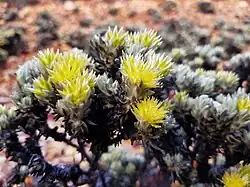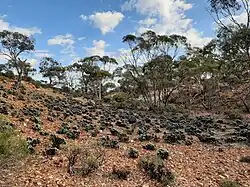Ptilotus helichrysoides
| Ptilotus helichrysoides | |
|---|---|

| |
| Scientific classification | |
| Kingdom: | Plantae |
| Clade: | Tracheophytes |
| Clade: | Angiosperms |
| Clade: | Eudicots |
| Order: | Caryophyllales |
| Family: | Amaranthaceae |
| Genus: | Ptilotus |
| Species: | P. helichrysoides
|
| Binomial name | |
| Ptilotus helichrysoides | |
| Synonyms[1] | |
| |

Ptilotus helichrysoides is a species of flowering plant in the family Amaranthaceae and is endemic to Western Australia. It is an erect, compact shrub with stem leaves arranged alternately and yellow flowers arranged singly or in oval to spherical spikes.
Description
Ptilotus helichrysoides is an erect, compact shrub, that typically grows to a height of up to 10–50 cm (3.9–19.7 in), its stems single and sometimes hairy or glabrous. The leaves on the stems are arranged alternately, 5–26 mm (0.20–1.02 in) long and 2–8 mm (0.079–0.315 in) wide. There are no leaves at the base of the plant. The flowers are yellow and arranged singly or in oval, hemispherical or spherical spikes, with hairy, colourless bracts 3.2–3.7 mm (0.13–0.15 in) long, and similar bracteoles 4.2–4.5 mm (0.17–0.18 in) long. The outer tepals are 6–7.7 mm (0.24–0.30 in) long and the inner tepals 5.5–7.3 mm (0.22–0.29 in) long. The style is straight, 4.1–4.7 mm (0.16–0.19 in) long and more or less fixed to the centre of the ovary. Flowering occurs from July to November.[2]
Taxonomy
This species was first formally described in 1859 by Ferdinand von Mueller who gave it the name Psilotrichum helichrysoides in his Fragmenta Phytographiae Australiae.[3][4] In 1868, von Mueller transferred the species to Ptilotus as P. helichrysoides in a later volume of Fragmenta Phytographiae Australiae.[5] The specific epithet (helichrysoides) means 'Helichrysum-like'.[6]
Distribution and habitat
This species of Ptilotus on rocky hillslopes and outcrops in the Avon Wheatbelt, Coolgardie, Geraldton Sandplains, Great Victoria Desert Murchison and Yalgoo bioregions of Western Australia.[2]
Conservation status
Ptilotus helichrysoides is listed as "not threatened" by the Government of Western Australia Department of Biodiversity, Conservation and Attractions.[2]
See also
References
- ^ a b "Ptilotus helichrysoides". Australian Plant Census. Retrieved 31 July 2025.
- ^ a b c "Ptilotus helichrysoides". FloraBase. Western Australian Government Department of Biodiversity, Conservation and Attractions.
- ^ "Psilotrichum helichrysoides". Australian Plant Name Index. Retrieved 31 July 2025.
- ^ von Mueller, Ferdinand (1859). Fragmenta Phytographiae Australiae. Vol. 1. Melbourne: Victorian Government Printer. pp. 237–238. Retrieved 31 July 2025.
- ^ "Ptilotus helichrysoides". Australian Plant Name Index. Retrieved 31 July 2025.
- ^ George, Alex S.; Sharr, Francis A. (2023). Western Australian Plant Names and Their Meanings - A Glossary (fifth ed.). Kardinya: Four Gables Press. p. 219. ISBN 9780645629538.